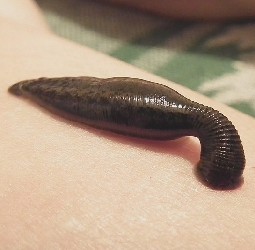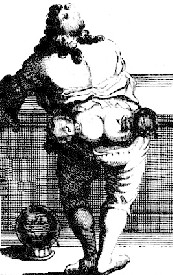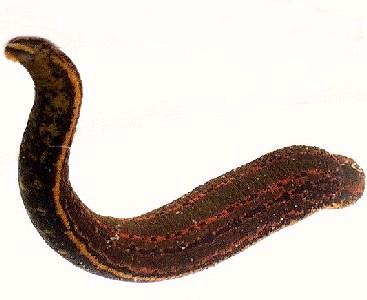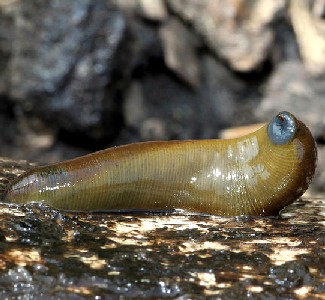
Leeches in Medicine Page Selection Menu: 1 2 3 4 5 Next>>
Leeches in Medicine During the Golden Age of Piracy, Page 2
Leech Use
Leeches actually had a couple of different medicinal uses during this period. The most obvious was that of bloodletting, but the period texts also suggested using them to stop headaches and remove poison.
Leech Use: Bloodletting
The primary use of leeches was to let blood during this time period. The primary reason for letting blood was to balance the humours in the body and/or to release the bad humors in the case of illnesses. Leeches were just one of many tools that the surgeon could use for this purpose.

A leech at its work
Since bloodletting was an important part of medicine at this time in history, it would take pages to cover how this was done in detail. (Fortunately, those pages have already been written and you will find them here if you want to learn more about this.)
For general bloodletting purposes, it was felt by period surgeons that leeches had some advantages over "breathing a vein" or otherwise letting blood with the aid of a scalpel or sharp fleem.
First, leeches were considered to be a milder method of bloodletting stemming from the natural anesthetic they produced. For this reason they were considered "safer for children and the very ill".1 John Atkins, author of The Navy Surgeon suggests using leeches on "old People and Children, when fearful and unfit for other Operation."2
Second, leeches could be applied to places where bloodletting through normal incision was either not possible or particularly painful. Pierre Dionis recommends that they be used in areas such as "the Face, the Lips, the Nose, the Joints, the Fingers, and the Anus: To which last Part they are applied to evacuate the Piles."3 Atkins also recommends leeches for places "where the Veins are small, out of Sight, or dangerous to attempt, such as the Hæmorrhoids, Gums, and temple".4

Cupping the posterior from
"Exercitationes Practicae Circa
Medendi Methodum" by Frederic
Dekkers, Table1 (1695)
Third, because of the anticoagulant released when the leech 'bites' a person, the wound often kept bleeding after the leech dropped off and could be kept going. Rory McCreadie explains, "The wound, if left, will bleed for 2 hours. It would have been at this point that the surgeon stepped in with his bleeding cups. A good surgeon could keep a leech wound bleeding for about 8 hours and take a pint or so of blood away."5
Bleeding cups are globes that have an open end like those seen on the gentleman's posterior at left. A lit wick or match is placed inside of the bleeding cup to burn up the oxygen inside the cup. When placed over the wound, the cup forms a vacuum as it cools, forcibly drawing blood out through the leech bite.
Mr. McCreadie also suggests a fourth reason for using leeches. As he explains, "It was also believe[d] that only bad or impure blood flowed from a leech bite, leaving the good or healthy blood in the body."6 I have not been able to find any evidence that this belief was held by period barber-surgeons beyond the normal belief that removing blood helped balance the body's humors, however.
1 John Kirkup, The Evolution of Surgical Instruments; An Illustrated History from Ancient Time to the Twentieth Century, p. 407; 2 John Atkins, The Navy Surgeon, p. 182 3 Pierre Dionis, A course of chirurgical operations: demonstrated in the royal garden at Paris. 2nd ed., p. 476; 4 Atkins, p. 182; 5 Rory W. McCreadie, The Barber Surgeon's Mate of the 16th and 17th Century, p. 58; 6 Ibid.
Leech Use: Curing Headaches

"Dude! I can help with that headache. Seriously."
photo by Karl Ragnar Gjertsen
This use is sort of an extension of humoral theory, but a very particular one. Matthias Gottfried Purmann gives us an account of curing a nobleman who "was extremely troubled with a continual Head-ach above the Quarter of a Year together."1 (I'll bet you thought your migraines were bad.)
Purmann explains how in 1686 he "opened the Temporal Artery on the left side" in an attempt to let blood from the patient and relieve his migraine. Purrman found that "the Nobleman had ease for about a Fortnight's time; but then the Distemper returned again, so that the Operation signified nothing at all; and the same Pain continued as formerly, till Leeches were applied, and afterward the Moxa [Also called mugwort or common wormwood], which freed him from that Infirmity for about half a Year, but then it returned again."
Scientific research has shown that, neither leeches nor other forms of bleeding such as opening a Temporal Artery do much good in the case of migranes2, although anyone who has ever had a really nasty migraine would probably be willing to try it anyhow.
1 All quotes without footnotes in this section are from Matthias Gottfried Purmann, Churgia Curiosa, p. 14; 2 Melissa Jackson, "The Humble Leech's Medicinal Magic", BBC Online, written 2 July, 2004, gathered 5/15/12
Leech Use: Removing Poisons
Only one of the authors I have read talks about using leeches for this purpose: Stephen Bradwell. In 1633, Bradwell wrote the book Helps For Suddain Accidents Endangering Life with the intent of providing a collection of remedies for everyday accidents, particularly to people who didn't have access to medical professionals. Many of his medical remedies are somewhat fantastic and sound more like witchcraft than medicine. In this case, however, he gives us a rather interesting comment that "Some apply Horseleeches to the [poisoned] wound, if it be very small."1 A horse leech (Haemopsis vorax) is a lesser leech in that it prefers to attack the sensitive lips and mouths of horses. They can actually digest the skin of live animals and feed on the tissue. They do not cut through the skin like the European or Medicine Leech.

A horse leech, photo by Holger Krisp
Horse Leeches aside, Bradwell prefers his own remedy, which is too bizarre not to repeat:
"Take a Pullet or Cockerell, bare his rump, and rube [rub] the fundament well with Salt; then hold it close to the wound, holding his beake closed with your hand, and giving him breath but now and then, onely to keepe him alive; and his fundament will draw out the venom. If one die, take another; and so continue till one of the creatures outlive the labour. Then may you bee sure the venom is cleane drawne out."2
Bradwell further suggests cupping following both of these treatments. Once "the patient appeare freed from all poysonous offence...apply Garlicke fryed with sweet Butter or sallet Oyle: to make sure that no remainder of mischeife be behinde: for it is an excellent outward Medicine against all Stingings and Biting that are venomous."3
In a similar manner, Bradwell suggests treating people bitten by a mad dog by drawing "the contagion out of the wound by cupping-glasses; application of Pullets or Pigeons that lay eggs, scarifications, Leeches, & drawing medicines".4 He gives a great deal more detail about the various methods that can be used to treat of the bite of a mad dog which are so fantastic they will have to await their own article on the topic. (Not that pirates would probably have much to fear shipboard from such creatures. At least one would hope.)
1Stephen Bradwell, Helps For Suddain Accidents Endangering Life, p.43; 2 Ibid.; 3 Ibid., p. 44; 4 Ibid., p. 60

